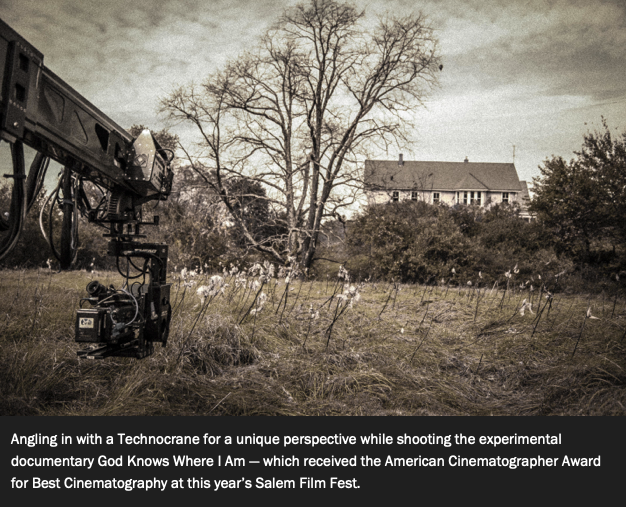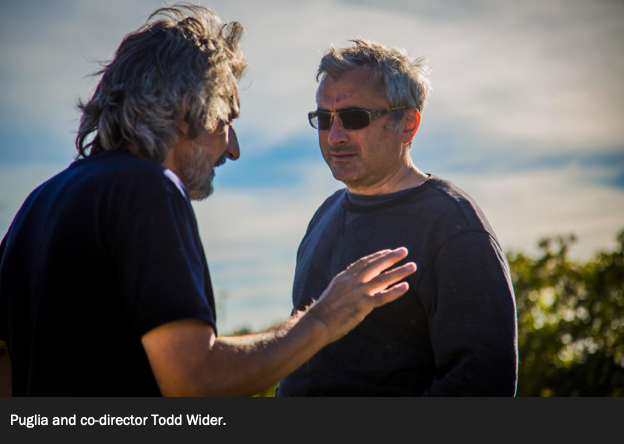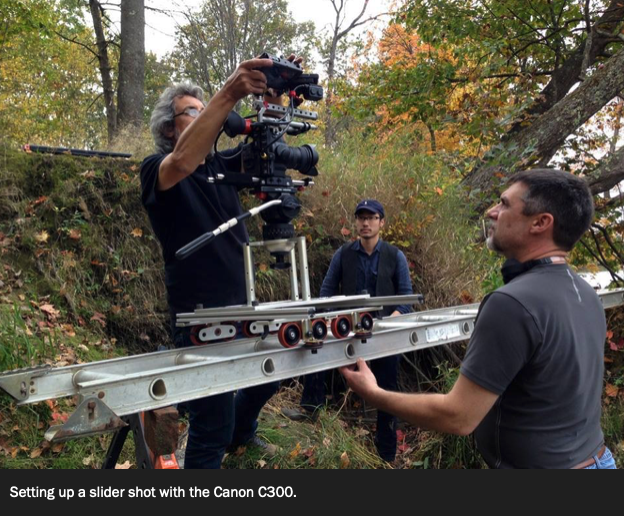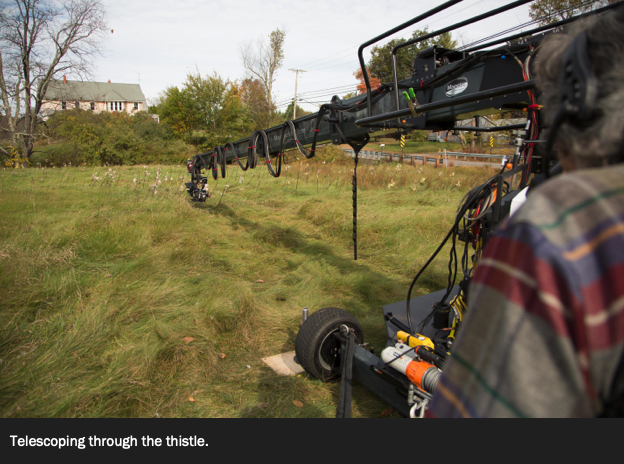God Knows Where I Am is a study of society’s failure to care for the mentally ill, as well as an experimental art film that explores the independent spirit of Linda Bishop, a middle-aged woman whose bipolar/schizophrenic disorder and desire for freedom led her to starve herself to death in an abandoned farmhouse in New Hampshire. To help craft an original approach to this difficult and complex subject, veteran and award-winning documentary producers and first-time directors Todd and Jedd Wider engaged their longtime friend, cinematographer Gerardo Puglia.
The Widers worked on the documentary for four years from concept to release, and Puglia dedicated two years, on and off, to shooting in the actual location where Bishop lived her last four months during a freezing New Hampshire winter, eating only apples stealthily picked from an old orchard and writing in a journal. In the documentary, actress Lori Singer gives voice to Bishop’s writing, which contrasts exquisite details about the natural world outside with the growing delusion that she would be rescued by a man she believed was her husband.

The resulting documentary received the American Cinematographer Award for Best Cinematography at 2017’s Salem Film Fest. Shortly after the festival, the cinematographer and co-directors spoke with AC about their approach to the complex material.
Todd Wider: My brother and I tend to be drawn to topics that have a sociopolitical resonance for us. This story about Linda was written in The New Yorker by Rachel Aviv, a wonderful writer. We began with a polemic about civil liberties: Where do you draw the line with the mentally ill? When do you medicate against someone’s will? When do you institutionalize against someone’s will? We began to interview experts on the topic, but as we spent more time with Linda’s diary, we felt we could make a more powerful film if we could create a more intimate view. We wanted to get more into her head.

Jedd Wider: I had taken several classes at Princeton that were taught by Gaetana Marrone-Puglia, Gerardo’s wife, around the history of Italy as seen through Italian cinema. They had a tremendous impact on me. My freshman year I was invited by her to head out to Jackson Hole, Wyoming, for several weeks to assist on a film, Woman in the Wind, that Gerardo was directing. It was a very rich experience; I became close with Gerardo, and I knew I would find my way into filmmaking — and, perhaps more importantly, I made a very distinct decision that I would make a film with Gerardo in the future. There was no cinematographer we wanted to work with more [for God Knows Where I Am]. Stylistically, he was the perfect choice for us.
Gerardo Puglia: I met with Todd and Jedd, and I read The New Yorker article, and then I also read the original diaries. We have a lot in common because we love the same filmmakers: Tarkovsky; Bergman; Antonioni; the Italian neorealists, such as Francesco Rosi. Since we were working in an empty house, I was most inspired by Bergman and Antonioni.

Todd Wider: From the very beginning we thought that we would create two arcs that would essentially go in different directions. One would be the diary arc, which would tell Linda’s version of what had occurred. The other arc would be the people around her, who either knew her in death or in life.
Jedd Wider: We did not write a script. We made the decision to direct the film based on two primary factors: the sociopolitical elements of the story, which really drive the film from a documentary perspective; and the visual elements of the film, which were, for us, extremely profound. This woman, who was mentally ill, was living in an isolated state in an abandoned farmhouse — and she was incredibly visual. She had been an art-history major, and she saw life through the lens of an artist.

Todd Wider: In our mind, the opening of the piece unfolds like a Rashomon event. You have a dead body inside of a building; you don’t know how it got there. Was the person killed? Did she commit suicide? Is it her house? Is it someone else’s house? What is she doing there? How did she get there? You have all these different perspectives, and they give you pieces of the truth, but you really do not know what the truth is. And then, finally, you are given Linda’s voice and you get Linda’s version of the truth.
Puglia: We started by just going through the house and studying the light and the patterns. One day I started filming the exteriors [with an Arri Alexa camera] — the reflections of the windows, just to get a feel of the house — using Angenieux Optimo 15-40mm [T2.6] and Optimo DP Rouge 30-80mm [T2.8] zooms. It was a spiritual experience in that we were rebuilding what Linda experienced. [For the Alexa footage, the filmmakers employed Arri’s Alexa Plus for tripod work and Alexa Classic for crane work. The cameras recorded 1920×1080 ProRes 4:4:4 to SxS cards.]
Jedd Wider: As we spent time in the house over two complete years — eight full seasons — we observed the same visuals that she noted in her journal. It was those observations that we knew would translate with the right cinematographer, with the right attention to the camera and lenses. I was thinking of [the ways in which director] Terrence Malick has endeavored through the years to depict a state of consciousness.
Puglia: This is when I said, ‘We should bring in a Technocrane because that is Terrence Malick’s favorite tool.’ I had also used it in the past. It has a spiritual effect — an emotional ‘G force.’ The Technocrane floats through the corridors and the rooms in a very powerful, ethereal way. I did not want to create the point of view of an actual person walking through the house — that’s why I did not use the Steadicam. We were not going to make a ghost story. Our crane operator, Mathieu Roberts, seemed quite impressed and told me, ‘No one ever uses the Technocrane to do documentary films!’
Jedd Wider: We assigned different thematic rationales for different types of cameras and film. To distinguish the various eras in Linda’s life, Gerardo chose Kodak stock to exploit grain, flares and sometimes streaks. When Linda was released from a psychiatric hospital, she wandered until she found the farmhouse. To display her energy and agitation, these scenes were shot with a 16mm Bolex and a Canon Scoopic — and Super 16mm sequences [were shot] using an Aaton XTR-Prod, sometimes without looking through the viewfinder. Gerardo even used his [Bell & Howell] Eyemo 35mm combat camera.

Puglia: [The Eyemo was] modified with a Nikon mount and [fitted with] a Zeiss 18mm lens. The Nikkor 50-300mm [f8] zoom was used on the Canon C300 to film the entire opening title/credit sequence of snowfall, including birds and deer.
Jedd Wider: Contemporary interviews were shot digitally with a Canon [EOS] C300 and 100mm [Zeiss lens at f4]. Eight-millimeter home-movie footage of Linda as a child is also incorporated.
Puglia: Super 16mm Kodak [Vision 500T] 7279 film was used to [capture] all the [sequences depicting] food, which Linda yearned for. [The slightly grainy quality of the] film has an enticing and dreamy effect; we wanted the viewer to experience Linda’s perception of food and to feel her hunger. Thirty-five millimeter [500T] 5279 was spooled off onto 100-foot rolls and used in the Eyemo camera. It was used to capture some of the internal landscapes of the house, as well as to evoke a sense of memory through it’s slight flicker and inconsistent exposure uniformity, which gave the images a sense of uneasiness. Film was sent to CineLab for processing and scanned at 2K.

Todd Wider: We also [used an] Arri Alexa, which we wanted to represent the eye of God; it is a presence, almost a ghost. When the camera starts outside the building, floats through the door, floats down the hallway and goes into the room where the apples are and where Linda spent most of her time looking out the window and writing in her diary — that was accomplished in one take with a 60-foot Technocrane.
Puglia: The [Technocrane rental] company we were using in New York was Majestic Motion Picture Technology. What I like about the Technocrane is that it telescopes, so you can do incredible moves. A lot of people think the Technocrane is just to get the camera up in the air, but once you set it up you can create extremely smooth ‘dolly’ moves. In the very beginning of the film, the slow move along the tree looks like it was made with a dolly, but it is the camera telescoping along the grass. Everyone is wondering, ‘Where are the dolly tracks?’ And there are none!
Jedd Wider: There were other elements that inspired us. One was the artistry of Vittorio Storaro [ASC, AIC], in particular the work he did in Bertolucci’s The Conformist. Storaro’s use of light, his grasp of chiaroscuro, had tremendous impact.
Puglia: I had met Storaro in Rome on the set of Bertolucci’s Luna and we’ve kept in touch over the years. But I am particularly indebted to Gordon Willis [ASC]; he was a good friend. I spent a lot of time with Gordon, and we talked about light and so forth. And I worked on A Beautiful Mind as an operator with Roger Deakins [ASC, BSC]. I liked what he was doing — he came from the school of reflected light. I learned from these three masters just by watching them work and having these discussions. In this film, the house gradually drew us in. It was a sacred place. It became a character. Everything I saw — the table, the chairs, the objects — represented Linda, and so every time I would see the way the light would fall on something, it moved me, it moved the crew, it moved everyone. I felt that it was Linda’s place. Everything was still in the house, original to what Linda had described in her diary. Even the blanket that she wore to keep herself warm was original. Her mattress was still there, books spread around. Everything was intact; nothing was brought in. We even found the original tree where she picked the crab apples, and we had the original stream where she would get water. Things happened at the right time. The light came out at the right time, the clouds came, and then it would start to snow at the right time. Everything was in sync and worked for us. We would be waiting for hours and then, all of a sudden, a bird would arrive and then snow would arrive. We were doing a crane move through the woods, and the wind would blow and all the leaves would come down right on cue. In post I only did a little fine tuning to affect the natural light.
Todd Wider: We all were very much involved with the color correction. [The grade was performed with Digital Vision Nucoda by Sean R. Smith at Technicolor-PostWorks New York.] This woman was so ill that she died under a red blanket in a freezing house with no electricity, starving to death simply because she was unable to get up, walk out of the room and leave. There were people living only yards away. It’s a tragedy about being a prisoner of one’s own mind; she died so alone and seemingly so forgotten. We wanted to make sure she is not forgotten. I think that so often we tend to minimize the value of those who are the most unfortunate and most vulnerable. We wanted to bring a measure of dignity back to a person who died in a way in which her dignity was so stripped away.
Puglia: We could not explain it, but everyone was moved by it. We are all proud of this very special film. At the end of the day’s shoot, when we would leave the house, I would privately thank Linda for allowing me to be a part of her life. In the end, it came out so well because Linda’s presence is in the film. Everything worked in a way [that was] like a religious experience.






















































SHARE: